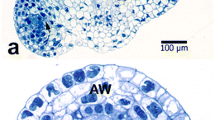Summary
Cytological changes associated with the final maturation, and dehiscence of the 16-grain compound pollen (polyads) have been followed in anthers at female and male phase of flowering. InAcacia retinodes, the transition from female to male phase takes approximately 24 h. The spherical generative cell at female phase is connected with the vegetative cell plasma membrane by a junction zone. This is sited adjacent to a germinal aperture, comprising wall ingrowths and membrane labyrinths. By male phase, the generative cell has elongated into a spindle-shape, and its surface is characteristically scalloped. The membrane labyrinths, especially those at the apertures, now contain masses of coated vesicles, implicated in the transport and secretion of proteins. Two-dimensional projections indicate that the generative cell and vegetative nucleus are closely associated forming a male germ unit.
Similar content being viewed by others
References
Bernhardt P, Kenrick J, Knox RB (1984) Pollination biology and the breeding systems ofAcacia retinodes (Leguminosae: Mimosoideae). Ann Missouri Bot Gard 71: 17–29
Cresti M, Ciampolini F, Kapil RN (1984) Generative cells of some angiosperms with particular emphasis on their microtubules. J Submicroscop Cytol 16: 317–326
Franchi GG, Pacini E (1980) Wall projections in the vegetative cell ofParietaria officinalis L. pollen. Protoplasma 104: 67–74
Kaul V, Theunis C, Palser B, Knox RB, Williams EG (1987) Association of the generative cell and vegetative nucleus in pollen tubes ofRhododendron. Ann Botany 59: 227–235
Kenrick J, Knox RB (1979) Pollen development and cytochemistry in some Australian species ofAcacia. Aust J Bot 27: 413–427
Knox RB (1984 a) Pollen-pistil interactions. In:Linskens HF, Heslop-Harrison J (eds) Cellular interactions. Springer, Berlin Heidelberg New York, pp 508–608
— (1984 b) The pollen grain. In:Johri BM (ed) Embryology of angiosperms. Springer, Berlin Heidelberg New York, pp 197–272
-Jobson S,Kenrick J,Dumas C (1987) Reproductive function in the mimosoid legume Acacia retinodes: developmental, ultrastructural and cytochemical characteristics of stigma receptivity. Am J Bot (submitted)
Levering CA, Thomson WW (1971) The ultrastructure of the salt gland ofSpartina foleisa. Planta 97: 183–196
Mogensen L,Wagner V (1987) Associations among components of the male germ unit following in vivo pollination in barley. Protoplasma (in press)
Nagahashi G, Leonard RT, Thomson WW (1978) Purification of plasma membranes from roots of barley. Specifity of the phosphotungstic acid-chromic acid stain. Plant Physiol 61: 993–999
Nakamura S, Miki-Hirosige H (1985) Fine-structure study on the formation of the generative cell wall and intine-3 layer in a growing pollen grain ofLilium longiflorum. Am J Bot 72: 365–375
Newman IV (1934) Studies in the Australian Acacias. II. The life history ofAcacia baileyana (FvM) Part 1. Some ecological and vegetative features, spore production and chromosome number. Proc Linn Soc NSW 99: 145–171
Oross JW, Thomson WW (1982) The ultrastructure of the salt glands ofCynodon andDistichlis (Poaceae). Am J Bot 69: 939–949
Pearse BMF (1982) Coated vesicles from human placenta carry ferritin, transferrin and immunoglobulin G. Proc Nat Acad Sci USA 79: 451–455
—,Bretscher MS (1981) Membrane recycling by coated vesicles. Ann Rev Biochem 50: 85–101
Roland JC (1969) Mise en évidence sur coupes ultrafines de formations polysaccharidiques directement associées au plasmalemme. CR Acad Sci, Paris 269: 939–942
— (1972) Phosphotungstic acid-chromic acid as a selective electrondense stain for plasma membranes of plant cells. Stain Technol 47: 195–200
— (1978) General preparation and staining of sections. In:Hall JL (ed) Electron microscopy and cytochemistry of plant cells. Elsevier, North Holland, Amsterdam, pp 1–62
—,Lembi CA, Morre DJ (1972) Phosphotungstic acid-chromic acid as a selective electron dense stain for plasma membranes from plant cells. Stain Technol 47: 195–200
Spurr AR (1969) A low-viscosity epoxy resin embedding medium for electron microscopy. J Ultrastruct Res 26: 31–43
Theunis CH, McConchie CA, Knox RB (1985) Three-dimensional reconstruction of the generative cell and its wall connection in mature bicellular pollen ofRhododendron. Micron and Microscopica Acta 16: 225–231
Author information
Authors and Affiliations
Rights and permissions
About this article
Cite this article
McCoy, K., Knox, R.B. The plasma membrane and generative cell organization in pollen of the mimosoid legume,Acacia retinodes . Protoplasma 143, 85–92 (1988). https://doi.org/10.1007/BF01291152
Received:
Accepted:
Issue Date:
DOI: https://doi.org/10.1007/BF01291152




